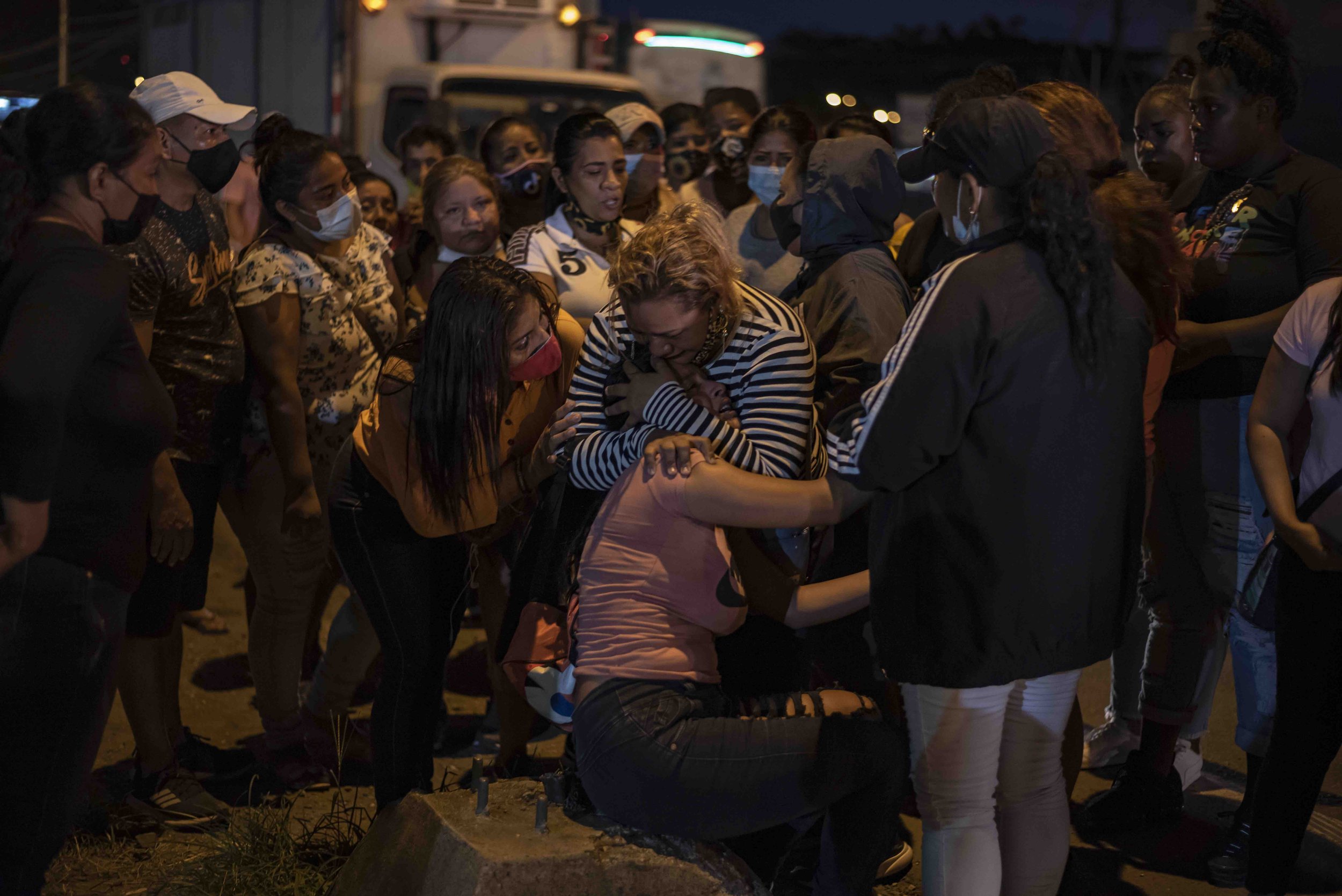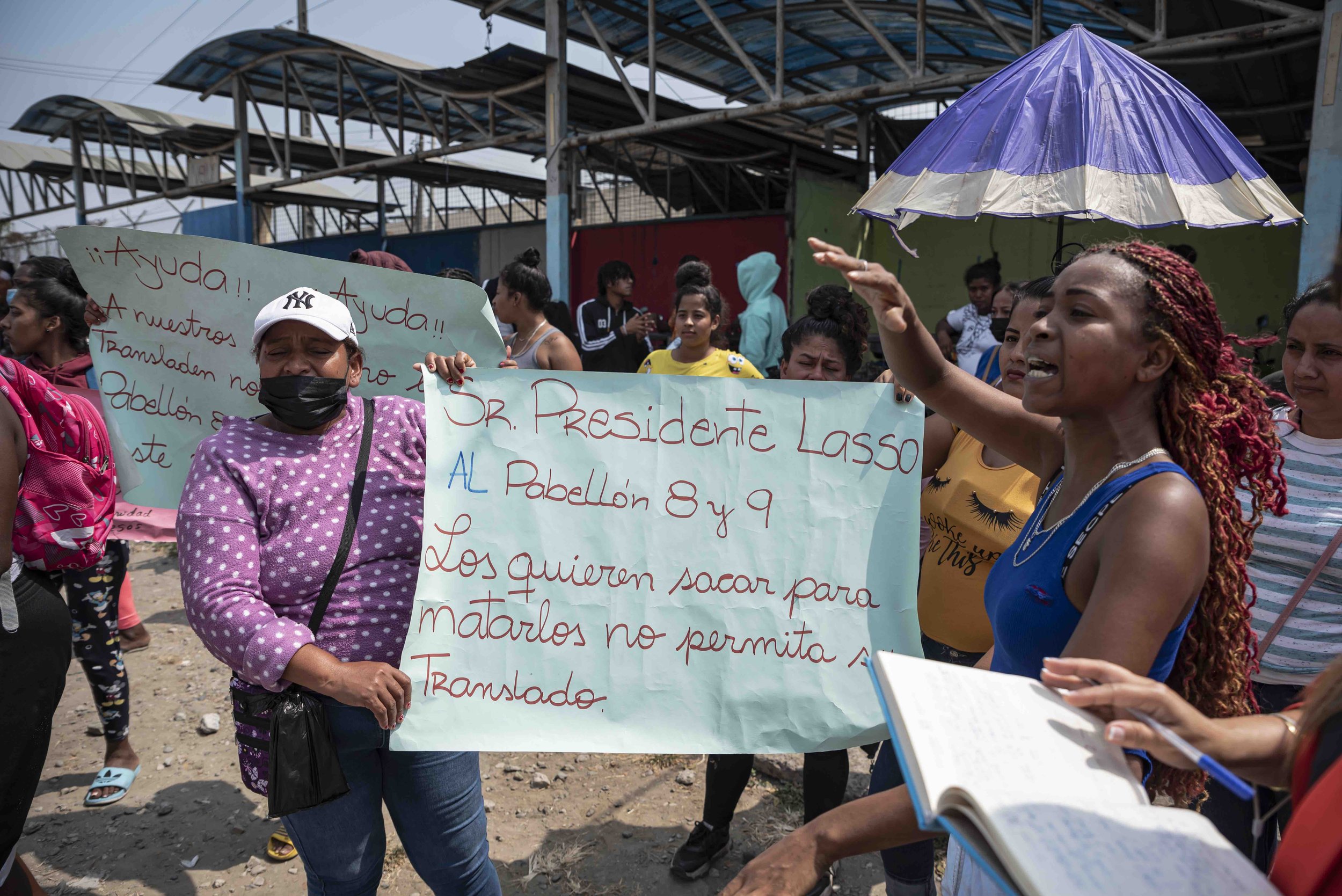Understanding Ecuador’s violent turn
A woman is consoled after learning of her husband's death in a prison riot via videos filmed inside the prison, which circulated on social media. February 23, 2021, Guayaquil, Ecuador. Photo: Vicente Gaibor.
Content warning: this story includes descriptions of murders and anti-Black police violence.
Reportage • Kimberley Brown • July 21, 2023 • Leer en castellano
Pedro is a 51 year old father from the city of Esmeraldas, a largely Afro-Ecuadorian city on the coast of Ecuador, which has recently been named one of the most violent cities in Latin America. Esmeraldas has long had its fair share of violence, but over the past year, Pedro says it’s gone too far.
“They kill. They kill in extravagant ways, in terrible ways. They cut heads off, light bodies on fire, and upload videos [to the Internet],” he told Ojalá via telephone. Pedro, like others we spoke to for this article, asked that we change his name out of fear of recrimination.
At first, this kind of extreme violence was concentrated among members of two local gangs, Los Tiguerones and Los Gangsters, who were fighting over territory. Recently, however, they and other groups have started extorting local individuals and small businesses. Those who can’t pay, pay with their lives or their families’ lives. People rarely report these crimes, as they fear retribution and don’t trust the police, who often work with the same criminal groups, says Pedro.
“Citizens are living in relentless fear,” he said.
Recent escalations of violence have put Ecuador in the news lately. The small South American country has one of the fastest-rising murder rates in Latin America. Right wing President Guillermo Lasso has blamed the violence on armed groups battling for control of the cocaine supply chain that passes through the country, with citizens getting caught in the cross-fire.
But many say this is only a part of the story. Rather, large-scale impunity and corruption, along with a weakened state and social fabric, are major factors that have led Ecuador to this point.
Prisons and the production of violence
As recently as 2018, Ecuador had one of the lowest homicide rates in Latin America.
Last year 4,603 violent deaths were registered, an 83 percent increase over the previous year. And 2023 looks set to be even worse. Coastal cities like Guayaquil and Esmeraldas are now ranked among the region’s most dangerous.
This surge in violence began not long after the first prison riots following the killing of a key gang leader in Ecuador in December of 2020. A long standing rivalry between gangs over leadership and territorial control became a war, within prison walls and on the outside. As homicides skyrocketed, riots in Ecuador’s penitentiary system continued. Over the past three years, more than 400 prisoners have been killed.
Last year, the Inter-American Commission of Human Rights (IACHR) released a report detailing corruption inside Ecuador’s prison system, where security guards allow guns, knives and explosives inside.
As the number of prisoners grows, prison budgets are cut back, while changing drug policies have led to an increase in prison sentences for selling drugs.
Juan, a 28-year old social work student in Guayaquil, told Ojalá his brother was killed in a prison riot in 2021, though the family doesn’t exactly know what took place. It took authorities two days to confirm that his brother was among the dead: prison guards didn’t know who was in what cell. Armed groups inside the prison control the prisoner registry, according to Juan.
While his brother was alive, his family paid for his food, his phone calls, his mattress, and if needed, they paid for him to be able to change prison cells. The family deposited the money into the personal accounts of whoever was running the service inside at the time.
Relatives of inmates protest with signs that read: "President Lasso, they want to remove them from Pavilions 8 and 9 to kill them, don't allow their transfer" in reference to the transfer of 200 inmates from the Penitenciaría del Litoral to other prisons. Guayaquil, Ecuador, November 1, 2022. Photo: Vicente Gaibor.
Juan is one of several family members of the incarcerated who formed the Committee of Families for Justice in Prisons in 2022. Earlier this year, the group launched a lawsuit against the state and national prison authorities alleging decades of negligence. They are demanding both individual and integral reparations, and a public apology from the executive.
Maria Fernanda Noboa Gonzalez, Ecuador coordinator for the Network of Women Specialized in Security and Defense in Latin America and the Caribbean, says Ecuador’s prisons are “a strategic rearguard of criminality,” under the control of criminal groups. They function as a safe haven from which these groups can organize their operations, and communicate with their members on the outside via whatsapp, or drones, she says.
Geographies of brutality
Ecuador’s geographic location—sandwiched between Colombia and Peru, two of the top cocaine processing countries in the world with a long coastline along the Pacific Ocean—has become a primary transit and dispatch point for cocaine going north.
Today, 28 armed groups have been identified in Ecuador, according to Noboa Gonzalez.
The majority of their activities are concentrated on the coast and along the northern and southern border zones with Colombia and Peru, directly controlling not only the cocaine trade leaving via the Pacific, but also weapons trafficking and human smuggling operations along the borders.
Juan, who lost his brother in prison, says Guayaquil has always been dangerous. In recent years, however, both the quantity and type of violence have changed, he says.
“Before, you could see someone had been shot, but you didn't see someone dismembered and left with a part of the body in one place and another part in another place. I didn't hear about that type of violence before,” he told Ojalá by phone. Today, it’s common, he said.
But violence is not just increasing along the coast.
Of the 15 most dangerous cities in Ecuador, where homicide rates have risen year over year since 2020, 10 are located along the coast. The other five are located in the central Andean provinces of Los Ríos, Cañar and Azuay, and are associated in official discourse either with drug trafficking or illegal gold mining.
Officials have warned of the increase of armed groups controlling illegal mining, logging and other resource related activities in the Amazon rainforest. These groups also have a strong presence in the central city of Santo Domingo de las Tsáchilas, a primary transit hub that connects most highways from the Amazon to the coast.
Quito, once the safest capital in Latin America, is also seeing an increase in armed robberies, and experienced a 90 percent increase in homicides last year compared to the year previous. Neighborhood self-defense groups have sprung up across the city, as residents contend police are not protecting them.
Earlier this year, one self-defense group in Comité del Pueblo, a neighborhood in northern Quito, attacked an abandoned house that an armed group was using as a safe house, sparking an hours-long armed stand off between residents and the criminal group.
State of exception and militarization
Over the past two years, President Lasso responded to violence by declaring at least 10 States of Exception. This put more soldiers on the streets and set strict curfews for residents often lasting for months at a time. Two of these States of Exception were nation-wide, the rest restricted to Guayaquil and Esmeraldas, or areas near prisons.
Earlier this year, President Lasso passed two decrees he said were designed to crack down on organized crime, raising the alarm among human rights groups in the country.
The first establishes the right of civilians to carry arms. The second allows the armed forces to suppress organized crime as a “terrorist threat,” meaning the military is on the street doing checks and other duties normally done by police. The government also says it’s been strengthening it’s police force, and announced 8,000 new graduates from police training programs would be deployed across the country.
Soldiers on patrol in Esmeraldas, Ecuador on April 28, 2023. Photo: Vicente Gaibor.
Lasso was in New York on Wednesday, where he signed a Memorandum of Understanding with the US to strengthen military cooperation. Details are still vague. The agreement will include facilitating the exchange of information related to security issues, training for the Ecuadorian Armed Forces, and increasing military presence along the border regions to “combat narcotrafficking and associated crimes,” according to a government press release.
Sofia Llerena, legal coordinator for the Quito-based Regional Human Rights Advisory Foundation (INREDH), is concerned with increased militarization and law enforcement on the streets as the only response to the rise in crime. Both institutions have a history of racial discrimination and excessive use of force against citizens, she told Ojalá. The majority of additional soldiers are deployed along the coast, in the capital Quito and in some areas in the Amazon where illegal mining is a problem, she says.
Llerena called attention to the recent cases of abuses against Christopher Santacruz and Carlos Reyes, both Black men assaulted by army personnel. Up to seven soldiers surrounded Santacruz in Quito, demanding his ID card as he got off the bus and throwing him against a pole, while one soldier appeared to try to stash a bag of marijuana in his backpack. In the city of Muisne, Esmeraldas, soldiers attacked Reyes for filming their actions against another youth. They then carried him away, beat him and cut his dreadlocks.
There is not yet any registry tracking these or similar incidents, says Llerena, who is concerned cases like these could become more widespread.
“This is a country with serious violations,” said Llerena in a video phone interview with Ojalá. “The current performance of the National Police and Armed Forces is worthy of criticism, and I believe there should also be a restructuring of the way in which they are being trained, and how that is being carried out.”
Llerena fears the situation could get even more violent across the country now that citizens are allowed to carry guns.
Austerity and violence
Noboa Gonzalez says there are many factors that have contributed to the country’s worsening security situation. But the institutionalization of corruption and impunity in the served as “two windows that were opened, allowing organized crime to enter,” she said.
In 2021, the U.S. Ambassador to Ecuador, Micheal Fitzpatrick, said he was concerned about the penetration of drug trafficking in Ecuador’s law enforcement, referring to corrupted top army generals and national police officials as “narco-generals.” The previous year, the U.S. withdrew 300 visas from Ecuadorian citizens who were being investigated for corruption.
Earlier this year La Posta released documents and recordings demonstrating links between key players in Lasso’s government and the Albanian mafia, which was one reason the president was facing an impeachment trial earlier this year. After the first hearing in May, Lasso dissolved the government via muerte cruzada (or “mutual death”), which put an end to his trial and ended talk about his mafia connections.
Rush elections for a new president and national assembly—who will serve for two years until regular general elections are held—will take place on August 20. Security is a key campaign issue, with most of the eight candidates promising to strengthen and purge law enforcement and the judicial system. But concrete details remain evasive. None of the candidates, left or right, are proposing demilitarization.
“As long as there is no radical and structural resolution of corruption and impunity, insecurity will never be remedied,” said Noboa Gonzalez.
Kleber Daniel Pontón Ceballos, professor at the IAEN School of Security and Defense in Quito, told Ojalá Ecuador’s security problems were inherited from the government of Lenin Moreno, who slashed social spending and closed several government ministries after accepting a $6.5 billion loan from the International Monetary Fund.
This has eaten away at Ecuador’s social safety net and the strength of state institutions, he says. In 2019 and 2022, Ecuadorians participated in massive anti-austerity protests, which lasted for days and led to stand-offs with police.
Llerena from INREDH says both police and the armed forces committed human rights violations over the course of the last national strike. Excessive use of force was used against civilians, and six people were killed and 150 protesters were arbitrarily detained. Looking forward, she’s increasingly worried about what uprisings against austerity measures will look like in the face of increased state and non-state violence.




